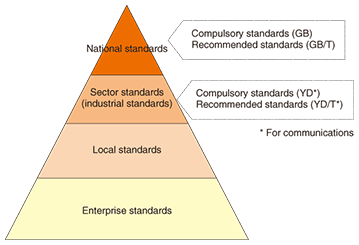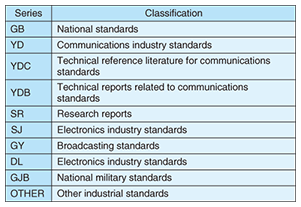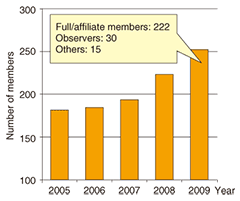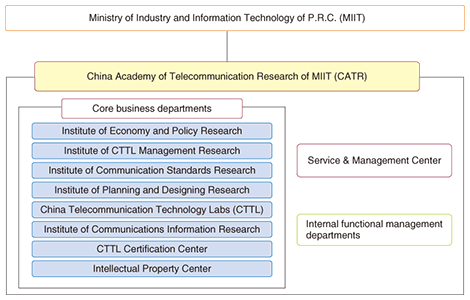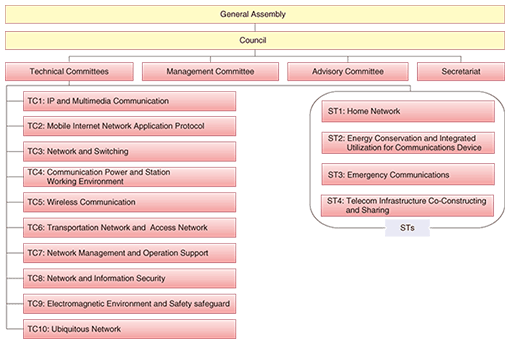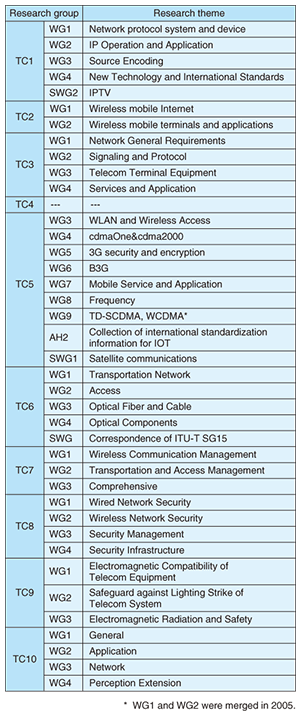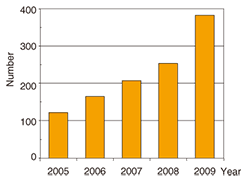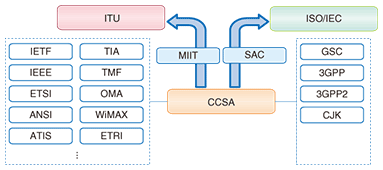 |
|||
|
|
|||
|
Global Standardization Activities Vol. 8, No. 12, pp. 22–28, Dec. 2010. https://doi.org/10.53829/ntr201012gls Standardization Trend of the Communications Field in ChinaAbstractChina is boosting innovation of independent technology in accordance with the “State Mid- and Long-term Scientific and Technological Development Plan Outline” issued by the State Council of The People’s Republic of China. All industrial fields are carrying out standardization work according to this goal of independent technology innovation: in the field of communications, the China Communications Standardization Association (CCSA) is responsible for standardization as the sole communications standardization organization. This article describes the latest trend of standardization in the Chinese communications industry, including the structure of the Chinese standards system.
1. IntroductionWith its entry into the World Trade Organization in 2001, China has taken on the obligation to abide by international standards according to the Technical Barriers to Trade (TBT) accord, which requires China to take international standards as the foundation of domestic standards. China promulgated the “State Mid- and Long-term Scientific and Technological Development Plan Outline” (mid- and long-term period plan) in February 2006 and is now accelerating the state strategy in the fields of science and technology fields up to 2020. These actions are based on four ideas: independent innovation, jumping into key fields, assistance for development, and driving toward the future. Their goal is to achieve original innovation (technological innovation owned by China), integration innovation (technological reform in combination with resources with intellectual property rights), and re-innovation (new technological reform through the introduction of advanced technology) through technological development via basic technology transition with the aim of popularizing basic research and advanced technology. In the mid- and long-term period plan, China is putting priority on and driving some key fields and preferred types of research. It is striving to vitalize the country with science and technology by 2020 by promoting this plan. The “Standard Development Plan in the Eleventh Five-year Plan” (March 2007) deriving from this mid- and long-term period plan is the basis of Chinese standardization policy. In accordance with the mid- and long-term plan outline, a variety of standardization work has been driven domestically and the China Communications Standards Association (CCSA) [1] is the sole entity undertaking this mission in the communications industry. China also made an Eleventh Five-year Plan (2006–2010) for communications, which stipulates twelve projects, and has been pushing this plan while setting concrete goals for achieving economic value, such as a next-generation Internet, next-generation broadband communications (fixed and mobile), and digital broadcasting. China is currently making an all-out effort to boost international standardization work. Moreover, it has become an administrative country in more international organizations such as ISO (International Organization for Standardization), IEC (International Electrotechnical Commission), and ITU (International Telecommunication Union) and is playing an increasingly important role in international standardization. It has also driven research and development (R&D) in a number of fields and its number of patent applications at home and abroad has been growing quickly in recent years (7907 applications for international patents in 2009 [2]). In recent years, China has submitted representative technical criteria to international standardization organizations, such as time division synchronous code division multiple access (TD-SCDMA), audio video coding standard (AVS), intelligent grouping and resource sharing (IGRS), wireless local area network authentication and privacy infrastructure (WAPI), and multimedia gateway in home networks (IEC62514). 2. China’s standardsIn accordance with the provisions of the Standardization Law of the People’s Republic of China (P.R.C.) (effective from 1989), China’s standards are classified into four types: national standards, sector standards (industrial standards), local standards, and enterprise standards (Fig. 1). Standards and criteria are classified into compulsory standards and optional (recommended standards). Compulsory national standards are prefixed by GB in standardization documents, while optional national standards have a GB/T label. Communications industry standards are prefixed by YD for compulsory standards and optional (recommended) standards. The classification of China’s technical standards is given in Table 1.
National standards are created and managed by the Standardization Administration of the P.R.C. (SAC) of the General Administration of Quality Supervision, Inspection and Quarantine of P.R.C. (AQSIQ), an authority directly under the central government. Sector standards are created and managed by industrial authorities of the central government: in particular, communications standards are created and managed by the Ministry of Industry and Information Technology of P.R.C. (MIIT). Local standards are created by different areas (provinces, autonomous regions, and municipalities directly under central government) under the jurisdiction of the Standards Departments of Local Administrations of Quality Supervision, Inspection and Quarantine. Enterprise standards are registered by different enterprises. The above jurisdictional relationships are shown in Fig. 2. SAC is a member organization of ISO/IEC.
In recent years, China has participated in a larger number of international standardization groups and taken up more important positions in these groups such as chair, vice-chair, and rapporteur. It has also gradually increased the number of its contributions to international standardization organizations. 3. CCSA3.1 Brief overviewCCSA was founded in 2002. Its membership is divided into full members, affiliate members, and observers representing research organizations, communications operators, vendors, universities, etc. The annual change in the number of members is shown in Fig. 3. In recent years, the membership has been growing. Besides 252 members representing organizations, there were 15 individuals from universities participating in the activities in 2009.
Responsibility for the core part of CCSA’s standardization work lies with the China Academy of Telecommunication Research of MIIT (CATR) [3], the sole domestic information and communications technology (ICT) organization under the government. CATR’s organizational structure is shown in Fig. 4. CATR is a research organization founded in 2003 directly under the leadership of MIIT, the former Academy of Posts & Telecommunications Science of the Ministry of Posts & Telecommunications (1956–1994). CATR is mainly providing assistance for the government’s communications policies, certification services, and consultation services. Meanwhile, CATR, on behalf of China, is positively taking part in domestic and international standardization work through CCSA’s technical committees and so on.
3.2 Organizational structure and domestic standardization workCCSA currently has technical committees (TCs) covering ten fields, which are carrying out work and boosting various standardization activities for GPON/GE-PON (gigabit capable passive optical network, gigabit Ethernet passive optical network), IPTV (Internet protocol television), NGN (Next Generation Network), B3G/4G (Beyond third generation; fourth generation), and IPv6 (Internet protocol version 6). There are also Special Teams (STs) for four feature themes. CCSA’s organizational structure is shown in Fig. 5 and the composition of the TCs’ Working Groups (WGs) is given in Table 2. Each TC also has a special WG (SWG) to boost the standardization research of special themes. In addition, some organizations represented by CCSA etc. are also responsible for implementing China’s independent innovation standard––TD-SCDMA specification and standardization operation of time-division Long Term Evolution (TD-LTE), which is further developing TD-SCDMA.
In 2010, CCSA has been boosting standardization activities in relevant fields like TD-SCDMA, TD-LTE, optical transport network (OTN), Internet Protocol Multimedia Subsystem (IMS), peer-to-peer (P2P) networking, IPTV, energy saving and emissions reduction, common construction of facilities, and the use and safety of the Internet. China has recently been pushing various types of research related to tri-network integration (integration of telecommunications, radio and television, and the Internet) and the Internet of Things (IoT, which is similar to the ubiquitous network concept). For tri-network integration, CCSA is providing further insights into IPTV and FTTx (fiber to various end points such as the home or building) for example; and for IOT-related topics, it is aggressively providing further insights into IPv6 to cope with the looming exhaustion of IPv4 addresses for example. To handle this trend, CCSA established the TC10 technical committee (ubiquitous networks) from 2010, which is actively engaged in IoT standardization for sensor networks and machine-to-machine communication. In combination with the trends of other standardization organizations and R&D organizations in this field, IoT in China is approaching the goal of realizing the concept of a Sensing China. The annual change in the number of relevant drafts of standards and criteria made by CCSA is shown in Fig. 6. In recent years, standardization work has been becoming active: in 2009, a total of 382 drafts (national standards, sector standards, technology reports, and research reports) were completed. The communications technology documents that have been established so far include 392 national standards, 2060 sector standards, 79 technical reference literature items, and 45 technical reports. Among them, 9 national standards, 314 sector standards, 9 technical reference literature items, and 16 technical reports were established in 2009.
Two members of the NTT Group have joined CCSA TCs as observers: NTT (holding company) has joined TC1 and NTT DOCOMO has joined TC5. They have also collected information about the status of communications standardization. 3.3 Cooperation with international standardization organizationsIn recent years, CCSA has positively boosted cooperative activities with international standardization organizations and standardization meetings. Some domestic standards and criteria in the communications industry made by CCSA were put forth by MIIT to ITU as international standards and criterion plans or proposed by SAC to ISO or IEC. CCSA is also making efforts to establish coordinative relationships related to standardization with various forums, alliances, and so on. These relationships are shown in Fig. 7 [1]. For instance, in 2009 CCSA submitted 845 contributions to ITU, 8022 contributions to 3GPP (3rd Generation Partnership Project), and 320 contributions to 3GPP2 (3rd Generation Partnership Project 2). In addition, according to reports, there are 25 Chinese people holding important positions in international standardization organizations, over 30 Chinese people have been appointed as WG leaders, and hundreds of Chinese people are responsible for drafting plans and performing other important work in this field. Clearly, China is strengthening its leadership in the international standardization field.
As an example of CCSA’s international standard coordination work, in December 2009 CCSA signed a communication memorandum for a “New Technology and New Standard Seminar” with ETSI (European Telecommunication Standards Institute) so as to boost international standardization work [4]. Both parties have performed research on communications in fields such as the ubiquitous network, IoT, next-generation Internet, home networks, IPTV, and environmental protection and energy-saving and research on international standardization strategy. Furthermore, at the China, Japan, Korea Meeting on Information and Telecommunication Standards (CJK Standards Meeting), the four electrical-communications–related standardization organizations from China, Japan, and Korea (CCSA in China, the Telecommunication Technology Committee (TTC) and the Association of Radio Industries and Business (ARIB) in Japan, and Telecommunications Technology Association (TTA) in Korea) exchanged information in order to boost the growth of the ICT industry and performed a variety of activities to contribute to international standardization. A recent discussion on ubiquitous networks also accelerated the work of “China, Japan and Korea to Enhance Communication and Cooperation in Ubiquitous Networks” [5]. Moreover, in August 2010, China held GSC-15 (15th Global Standards Collaboration meeting) [6] in Beijing, hosted by CCSA. 4. Concluding remarksAs shown by activities like the Beijing Olympic Games in 2008 and Shanghai World Expo in 2010, the Chinese market has been becoming active economically and technologically. In accordance with its mid- and long-term scientific and technological development plan promulgated in 2006, China is making efforts to revitalize the country with technology by 2020 and effectively boost policies of independent innovation covering an extensive range of fields from basic to applied research. In the future, through its Twelfth Five-year Plan (2011–2015), China will further boost technological development and cooperation with international standardization organizations. On behalf of the NTT Group, my colleagues and I will continue to collect information about the trend of standardization in the Chinese ICT industry and will explore and promote cooperative relationships with China. References |
|||








